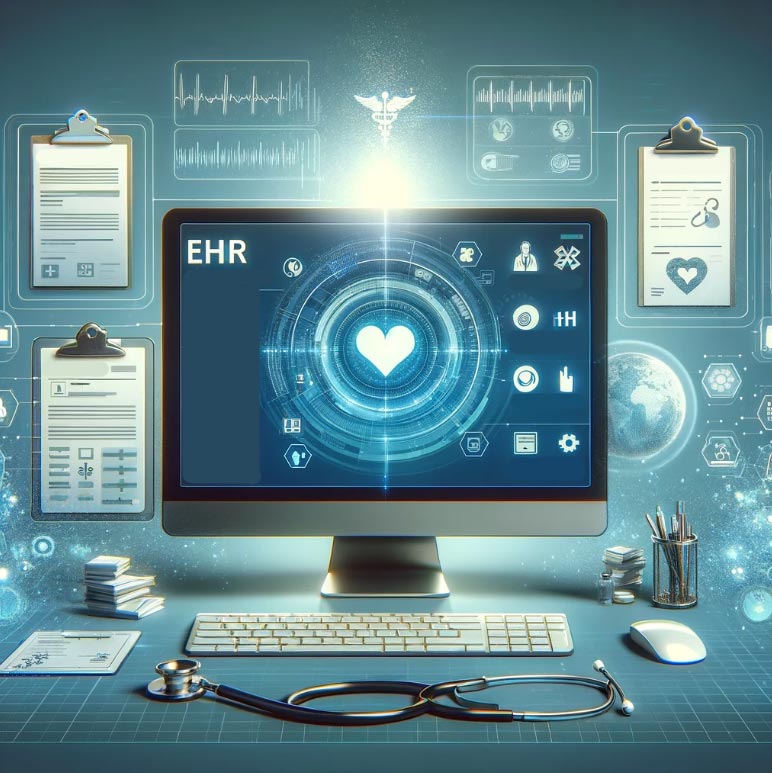Key Points:
- EHR software is a digital solution for storing, managing, and accessing patients’ medical records.
- The core function of EHR software is to focus on the patient’s medical history, treatments, and health outcomes.
- Immediate access to patient records enables healthcare providers to make informed decisions quickly, reducing the risk of errors.
- EHR software focuses on the clinical aspects of healthcare delivery.
- EHRs are patient-centered records that make information available instantly.
What is EHR Software?
Electronic Health Records (EHR) software represents a pivotal shift in healthcare’s digital landscape, streamlining patient information management and facilitating a more integrated, patient-centered approach to medical care. This article delves into the essence of EHR software, exploring its features, benefits, and transformative impact on the healthcare industry.
Understanding EHR Software
EHR software is a digital solution for storing, managing, and accessing patients’ medical records. Unlike traditional paper records, EHRs provide a comprehensive, real-time patient history, including diagnoses, treatment plans, immunization dates, allergies, radiology images, and laboratory test results. The software enables healthcare providers to access this information instantly, fostering more efficient and coordinated patient care.
Key Features of EHR Software
EHR systems come with a suite of features designed to enhance the delivery of healthcare services. These include:
- Electronic Medical Records (EMR): The core function of EHR software is to focus on the patient’s medical history, treatments, and health outcomes.
- Patient Portals: Online platforms that allow patients to access their health information, schedule appointments, and communicate with healthcare providers.
- E-Prescribing: Enables providers to send prescriptions electronically to pharmacies, improving prescription accuracy and convenience.
- Decision Support Systems: Analytical tools that assist healthcare providers in making evidence-based clinical decisions.
- Health Information Exchange (HIE): Facilitates the secure sharing of patient information across different healthcare settings, promoting coordinated care.
Benefits of EHR Software
The adoption of EHR software brings a multitude of benefits to both healthcare providers and patients:
- Enhanced Patient Care: Immediate access to patient records enables healthcare providers to make informed decisions quickly, reducing the risk of errors and improving patient outcomes.
- Increased Efficiency: EHR software automates many administrative tasks, such as scheduling and billing, allowing healthcare providers to focus more on patient care.
- Improved Coordination: By facilitating the exchange of patient information among different healthcare providers, EHRs ensure that care is more coordinated and seamless, especially for patients with complex conditions.
- Data Security and Privacy: EHR systems employ advanced security measures to protect patient information, complying with regulatory standards like HIPAA in the United States.
- Patient Empowerment: Through patient portals, EHRs engage patients in their own care, providing them with the tools to manage their health more proactively.
Implementation Challenges
Despite their benefits, the implementation of EHR systems is challenging. These include:
- High Costs: The initial setup and ongoing maintenance of EHR software can be expensive, posing a significant barrier for small practices.
- Complexity and Usability Issues: Some EHR systems can be complex and challenging to use, requiring extensive training for healthcare staff.
- Interoperability Concerns: The ability of different EHR systems to communicate and exchange information is crucial for coordinated care but remains a challenge due to varying standards and technologies.
- Privacy and Security Risks: While EHRs are generally secure, digitizing health information raises concerns about data breaches and unauthorized access to patient records.
The Future of EHR Software
The future of EHR software lies in overcoming current challenges and harnessing emerging technologies to further enhance healthcare delivery. Innovations such as artificial intelligence (AI), machine learning, and blockchain can improve EHR functionality, interoperability, and security. For instance, AI can offer more sophisticated decision support, while blockchain technology promises a new level of data integrity and security.
Furthermore, integrating EHRs with telehealth and remote monitoring technologies is expanding the boundaries of traditional healthcare, enabling care delivery in a more flexible and patient-centric manner. This integration improves access to care for patients in remote areas. It facilitates a more personalized and proactive approach to health management.
EHR software is at the forefront of the digital transformation in healthcare, offering a more efficient, secure, and patient-centered approach to managing health information. While challenges remain in the widespread adoption and optimization of EHR systems, the potential benefits for healthcare delivery, patient outcomes, and the overall healthcare system are significant. As technology continues to evolve, the future of EHR software looks promising, with the potential to revolutionize healthcare in ways that are currently unimaginable. Embracing this digital evolution is essential for healthcare providers aiming to offer the highest standards of patient care in the 21st century.
Do Medical Offices Need Both EHR and Practice Management Software?
Electronic Health Records (EHR) Software
EHR software focuses on the clinical aspects of healthcare delivery. It enables the digital storage, retrieval, and updating of patient medical histories, including diagnoses, medications, treatment plans, immunization dates, allergies, and test results. EHRs are patient-centered records that make information available instantly and securely to authorized users. They support healthcare providers in making informed decisions by providing comprehensive patient health information and facilitating better patient outcomes.
Practice Management (PM) Software
Conversely, PM software emphasizes a medical practice’s administrative and financial operations. This includes appointment scheduling, billing, insurance claims management, and reporting. PM systems are designed to streamline healthcare business, improving administrative tasks’ efficiency, reducing errors, and enhancing patient satisfaction through better service delivery. They also play a crucial role in managing the revenue cycle, ensuring that practices are reimbursed for services.
The Synergy of EHR and PM Software
While both types of software offer distinct functionalities, their integration can significantly enhance the efficiency and effectiveness of medical offices. Here are several reasons why:
- Comprehensive Patient Care: EHR and PM systems work together to provide a holistic view of the patient’s journey, from the clinical to the administrative. This integrated approach ensures that healthcare providers have access to both health and administrative data, enabling them to deliver care that is not only effective but also well-coordinated with the patient’s scheduling, billing, and insurance needs.
- Streamlined Workflows: Integrating EHR with PM software can automate the transfer of information between clinical and administrative areas. For example, information from a patient’s visit, captured in the EHR, can automatically update billing and insurance claims in the PM system, reducing manual entry and the potential for errors.
- Improved Financial Performance: An integrated system can enhance a practice’s financial health. Accurate and efficient billing, facilitated by the seamless flow of information from EHR to PM software, can lead to faster reimbursement and reduced denials from insurance companies.
- Enhanced Patient Experience: Patients benefit from the synergy of EHR and PM systems through smoother interactions with medical offices. Online appointment scheduling, timely reminders, efficient check-ins, and simplified billing processes contribute to a better patient experience.
Frequently Asked Questions:
What is EHR Software?
EHR software, or Electronic Health Record software, is a digital system used by healthcare providers to collect, store, manage, and share patients’ health information. It includes comprehensive data such as medical history, diagnoses, medications, treatment plans, immunization dates, allergies, radiology images, and laboratory test results. EHR software aims to streamline the workflow of healthcare professionals and improve the quality of patient care by ensuring that accurate and up-to-date information is readily available.
What is Meant by EHR Software?
EHR software refers to a digital solution designed to replace traditional paper-based medical records with an electronic version. This software helps healthcare providers maintain detailed records of patient interactions and medical history, facilitating better clinical decisions and coordinated care. EHR software typically includes features for scheduling, billing, e-prescribing, and reporting, making it an integral part of modern healthcare practices.
What is the Difference Between EHR and EMR?
The main difference between Electronic Health Records (EHR) and Electronic Medical Records (EMR) lies in their scope and functionality:
- EMR: Electronic Medical Records are digital versions of paper charts in a clinician’s office. They contain the medical and treatment history of patients within one practice. EMRs are primarily used by providers for diagnosis and treatment.
- EHR: Electronic Health Records go beyond the data collected in one practice’s office and are designed to share information with other healthcare providers. EHRs are more comprehensive and include data from all the clinicians involved in a patient’s care, facilitating better coordination and continuity of care.
What is the Most Popular EHR System?
The popularity of EHR systems can vary depending on the region and specific needs of healthcare providers. However, as of recent years, some of the most popular EHR systems in the United States include:
- Epic Systems: Widely used by large hospital systems and healthcare organizations due to its comprehensive features and interoperability.
- Cerner: Another leading EHR system, known for its flexibility and robust functionality.
- MEDITECH: Popular among smaller healthcare providers and community hospitals.
- Allscripts: Offers a variety of solutions tailored to different sizes and types of healthcare practices.
What are Examples of EHR in Healthcare?
Examples of EHR systems used in healthcare include:
- Epic Systems: Known for its extensive functionalities and use in large healthcare organizations.
- Cerner: Provides solutions for hospitals and health systems, focusing on improving patient care and outcomes.
- MEDITECH: Commonly used in community hospitals and smaller healthcare facilities.
- Allscripts: Offers solutions for various practice sizes and specialties.
- NextGen Healthcare: Designed for small to mid-sized practices, focusing on usability and patient engagement.
These systems help healthcare providers manage patient information, enhance care coordination, and improve overall healthcare delivery.




